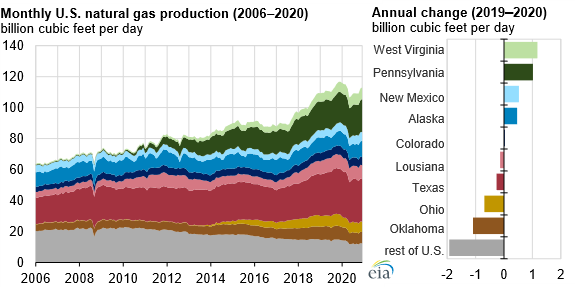U.S. Natural Gas Production Decreased by 1% in 2020
By U.S. Energy Information Administration

U.S. natural gas production — as measured by gross withdrawals — averaged 111.2 billion cubic feet per day (Bcf/d) in 2020, down 0.9 billion Bcf/d from 2019 as result of a decline in drilling activity related to low natural gas and oil prices in 2020.
The 2019 record-high increase in natural gas production led to higher volumes of natural gas in storage and lower natural gas prices. Beginning in March 2020, warmer-than-average weather along with the effects of the responses to COVID-19 drove down natural gas demand and further reduced prices. The lowest average monthly U.S. natural gas production volume was in May 2020 at 106.4 Bcf/d. By December 2020, natural gas production had increased to 113.0 Bcf/d.

The Appalachia region remains the largest natural-gas producing region in the United States. Natural gas production from the Marcellus and Utica/Point Pleasant shales of Ohio, West Virginia, and Pennsylvania continued to grow despite low regional natural gas spot prices. Natural gas production from these three states increased from 32.1 Bcf/d in 2019 to 33.6 Bcf/d in 2020. Within the Appalachia region, West Virginia had the largest increase in natural gas production, increasing by 1.2 Bcf/d, or 20%, to reach 7.1 Bcf/d. Natural gas production increased by 1.0 Bcf/d in Pennsylvania and decreased by 0.7 Bcf/d in Ohio.
In 2020, Oklahoma had the largest decrease in natural gas production, falling by 1.1 Bcf/d, or 13%, to an annual average of 7.6 Bcf/d. Texas remained the largest natural-gas producing state, although natural gas production in the state decreased from 28.4 Bcf/d in 2019 to 28.1 Bcf/d in 2020.
Related News
Related News

- Trump Aims to Revive 1,200-Mile Keystone XL Pipeline Despite Major Challenges
- ONEOK Agrees to Sell Interstate Gas Pipelines to DT Midstream for $1.2 Billion
- Energy Transfer Reaches FID on $2.7 Billion, 2.2 Bcf/d Permian Pipeline
- Boardwalk Approves 110-Mile, 1.16 Bcf/d Mississippi Kosci Junction Pipeline Project
- Kinder Morgan Approves $1.4 Billion Mississippi Crossing Project to Boost Southeast Gas Supply
- Tullow Oil on Track to Deliver $600 Million Free Cash Flow Over Next 2 Years
- GOP Lawmakers Slam New York for Blocking $500 Million Pipeline Project
- Energy Transfer Reaches FID on $2.7 Billion, 2.2 Bcf/d Permian Pipeline
- Enbridge Should Rethink Old, Troubled Line 5 Pipeline, IEEFA Says
- Polish Pipeline Operator Offers Firm Capacity to Transport Gas to Ukraine in 2025




Comments